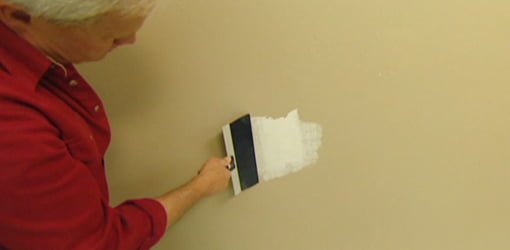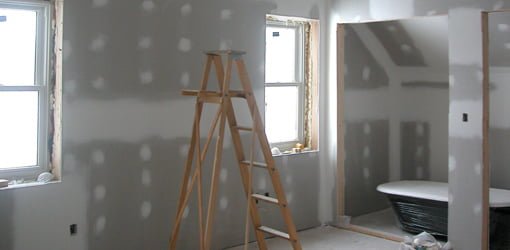If you’re planning a renovation or drywall repair, you’ve probably heard both Sheetrock and drywall used to describe the same thing. And for the most part, they are — but there’s a small difference worth knowing. Sheetrock is simply a brand name for drywall, much like Kleenex is for tissues.
From a cost and installation standpoint, there’s virtually no difference between Sheetrock and other drywall brands. Standard drywall installation costs between $1.50 and $3.00 per square foot, or $60 to $90 per panel when hiring a pro. If you’re going the DIY route, expect to spend $100–$500 on tools and materials.
In this guide, we’ll explain the key differences between Sheetrock and generic drywall, explain the various types available, and help you decide which one is best for your home project — whether you’re finishing a basement, building a new room, or just replacing a damaged wall.
What Is Drywall?
Drywall is a construction material for building interior walls and ceilings in most modern homes. It’s made of a gypsum core sandwiched between two sheets of durable paper, offering a quick, cost-effective alternative to traditional plaster walls.
Originally developed as “Sacketboard,” drywall replaced the labor-intensive process of installing wooden lath strips and applying layers of wet plaster. Early versions still needed a final coat of plaster before painting, but today’s drywall is ready to finish as-is. Once installed, all you need to do is tape the seams, cover the screw holes with the joint compound, and sand everything before painting.
Drywall became the standard because it’s fast to install, affordable, and versatile enough to suit everything from basic living rooms to high-moisture bathrooms (with the right type).
What Is Sheetrock?
Sheetrock is just a brand of drywall made by the U.S. Gypsum Company (USG), one of the industry’s biggest names.
All Sheetrock is drywall, but not all drywall is Sheetrock. Other manufacturers make similar products, often at slightly lower prices. That said, many contractors prefer Sheetrock for its consistent quality and fewer defects out of the box.
So, if someone recommends Sheetrock for your project, they’re not talking about a different material — just a trusted brand of the same thing.
Key Differences Between Sheetrock and Drywall
The only real difference between Sheetrock and drywall is branding.
- Sheetrock is a brand name made by USG.
- Drywall is the general term for the product — gypsum board wrapped in paper — made by many manufacturers.
There’s little to no difference between Sheetrock and other reputable drywall brands in terms of performance, installation, and lifespan. However, Sheetrock may offer more consistent quality control, which is why many pros prefer it.
For homeowners, the takeaway is simple: whether your contractor uses Sheetrock or another quality brand, you’re getting the same type of wall material.
Types of Drywall
Not all drywall is the same. Depending on where you’re installing it, you’ll want the right type for the job. Here are the most common options:
Standard Drywall
This is the everyday drywall used in most living spaces. It’s typically ½ inch thick for walls. For ceilings, use either ½-inch no-sag panels or thicker ⅝-inch panels to prevent drooping between joists.
Moisture-Resistant (Green Board)
Ideal for bathrooms, laundry rooms, and kitchens. It’s water-resistant but not waterproof — it can still absorb water if exposed for too long.
Mold-Resistant Drywall
Designed for humid areas like bathrooms and basements. It includes mold-inhibiting additives and is available in colors like green, yellow, purple, or blue.
Fire-Rated Drywall
Required by code in areas like garage ceilings (especially under living spaces). These ⅝-inch panels slow fire spread and typically offer a one-hour fire rating.
Soundproof Drywall
Used in home theaters or shared walls between rooms. This type is part of a system that includes multiple layers and sound-dampening materials to reduce noise.
Lightweight Drywall
Easier to carry and hang, especially on ceilings. It performs like standard drywall but weighs less (a bonus if you’re tackling a DIY job).
Paperless Drywall
Instead of paper facing, it uses fiberglass, making it highly resistant to mold and water damage. It’s a popular upgrade in wet areas or custom showers.
Drywall Sizes and Thicknesses
Drywall panels come in a few standard sizes and thicknesses. Choosing the right one depends on where you’re installing it and what the space requires.
Common Panel Sizes
- 4′ x 8′: Most common size; easy to transport and install.
- 4′ x 12′: Covers more area with fewer seams; great for tall walls.
- 4′ x 16′: Special order only; used in large rooms or commercial projects.
Typical Thickness Options
- ¼ inch: Best for curved surfaces or layering over existing walls.
- ⅜ inch: Used for repair work or when matching older wall thicknesses.
- ½ inch: Standard for most interior walls in homes.
- ⅝ inch: Required for fire-rated areas or ceilings that need extra strength.
Quick Tip: For ceilings, go with ½-inch no-sag or ⅝-inch panels to prevent drooping over time — especially in rooms with wider joist spacing.
DIY Drywall Installation: Is It Possible?
Yes, you can install drywall yourself, but be ready for a workout and a learning curve. Here’s what to consider before diving in:
- Weight: Drywall panels are heavy, especially the longer ones. If you’re working on a ceiling, rent a drywall lift to save your back and avoid injuries.
- Tools: A cordless drill works, but a drywall screw gun speeds things up and sets screws at the right depth every time.
- Fasteners: Use drywall screws instead of nails. They’re less likely to pop over time and provide a tighter, longer-lasting hold.
- Finishing: This is where most DIYers struggle. Achieving a smooth, seamless finish takes patience and practice. You’ll need to apply drywall compound, sand between coats, and feather the edges for a pro-level look.
If you’re comfortable with tools and detail work, DIY drywall is doable. Just budget extra time, and don’t skimp on prep. The right tools and techniques will make or break the final result.
Choosing the Right Drywall for Your Project
Not all drywall is created equal. The right type depends on where you’re installing it and what conditions the room faces.
- Living Areas: Use standard ½-inch drywall. It’s perfect for bedrooms, living rooms, and hallways — anywhere moisture isn’t an issue.
- Bathrooms and Kitchens: Go with ½-inch water-resistant or mold-resistant drywall. These help prevent moisture damage and mold growth in humid environments.
- Garage Ceilings (with living space above): Building codes usually require ⅝-inch fire-rated drywall in these areas. It slows fire spread and adds an extra layer of safety.
- Home Theaters or Shared Walls: Use two layers of ½-inch soundproof drywall or a sound-deadening system to reduce noise transfer and keep the audio contained.
- Ceilings: Choose either ½-inch no-sag panels or standard ⅝-inch panels to prevent sagging, especially in large rooms or where joists are spaced wider apart.
Pro Tip: Always check your local building codes. If you’re unsure, talk to a contractor or building inspector before you buy materials.
Drywall Vs. Sheetrock Installation Costs
Whether you choose generic drywall or brand-name Sheetrock, the cost differences are minimal. What matters more is the type of drywall you need and whether you hire a pro or go the DIY route.
Professional Installation
Expect to pay $60–$90 per panel, including materials and labor. That works out to around $1.50–$3.00 per square foot depending on complexity and drywall type.
DIY Installation
If you’re doing it yourself, material costs are lower, but you’ll need tools like a screw gun, taping knives, and possibly a drywall lift. DIY projects typically cost $100–$500, depending on the tools you already own.
Finishing Costs
Professional taping, mudding, and sanding add another $1.50–$3.50 per square foot. While DIY finishing is possible, achieving a smooth, paint-ready surface takes practice.
Sheetrock Vs. Generic Brands
Sheetrock may cost slightly more, but many contractors prefer it for its consistent quality, fewer defects, and easier installation. For most homeowners, the extra cost is negligible and may be worth it for a smoother job overall.
So, Is It Better To Use Sheetrock or Generic Drywall?
At the end of the day, the difference between Sheetrock and drywall comes down to branding — not performance. What matters more is choosing the right type of drywall for each space in your home, whether it’s moisture-resistant panels for bathrooms, fire-rated drywall for garages, or standard boards for living areas.
If you’re hiring a contractor, don’t stress over whether they use Sheetrock or another brand — focus on the correct type, proper installation, and code compliance. And if you’re tackling the job yourself, take your time, use the right tools, and don’t underestimate the finishing process.




